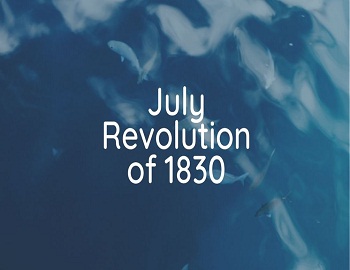July Revolution of 1830:
After the fall of Napoleon, the Bourbon line of King was restored in the person of Louis XVIII, brother of Louis XVI. The new monarch was determined to act constitutionally. He issued the famous Constitutional Charter which established a legislature of two houses- the Chamber of Peers, appointed for life and the Chamber of Deputies, elected for a period of five years by a restricted body of voters. The charter also proclaimed that all were equal before the law and to be equally eligible for all public positions. Yet equality of the people did not exist. France was still in a political sense the land of privilege, only privilege was no longer based on birth but on fortune.
Louis XVIII was confronted by two hostile parties. On the one hand, there existed the Ultra Royalists who were more loyalists than the king. On the other hand, there were the moderates who based their policy on the maintenance of the Charter. There was also a party of the Left-Republicans, Bonapartists and others.
From 1816 to 1820 the government of France with the assistance of two successive ministers- Richelieu and Decazes, was able to proceed on liberal lines. But in 1820 Duke of Berry, the intended heir to the throne was murdered. This caused much indignation and strengthened the Ultra-Royalist. Richelieu returned for a short time, but he could do nothing against the forces of reaction which had set in. The successor of Richelieu was Villele who remained in office from 1821 to 1827. By his reactionary measures, he imposed censorship of the press and drastically revised the electoral law to the advantage of the wealthy class. The elections of 1824 returned an overwhelming majority of the Ultras of which only fifteen were liberals, In 1824 the aged Louis XVIII died, leaving the throne to his younger brother, Charles X.
The new King, Charles X was a man of little common sense. He was ultra-reactionary and was regarded as the head of the emigres. He strengthened the power of the Church and permitted the Jesuits to return to France. The election of 1827 returned a majority adverse to the ministry and Villele resigned office.
Villele’s successor was Martignac. He pursued a policy of compromise which, however, met with no support either from the Liberals or from the Ultra-royalists. Charles X dismissed Martignac and appointed in 1829 a most unpopular minister, Prince Polignac. The new minister announced his determination to reorganize society, to give the clergy their weight in State affairs, ‘to create a powerful aristocracy and to surround it with privileges’. The French people protested. They began to talk of the Revolution of 1688, of William of Orange, and of Parliamentary Monarchy. Societies to resist illegal taxation were formed. Agitators, like Lafayette, toured the country.
Charles X fell back upon the schemes of spirited foreign policy which, he thought, would reconcile France to the loss of liberties. The French army moved to Algiers and its conquests laid the foundation of the French dominion in North Africa. But Paris, however, was not interested in Algiers, but in the crucial controversy between Crown and people. The Chamber of Deputies petitioned the King to dismiss Polignac. In 1830 Charles dissolved the Chamber. In the elections which ensued, the government was in a hopeless minority. This was the occasion for the coup d’ eat. The King’s mind was fixed. ‘Concessions ruined Louis XVI’, said he, ‘I have either got to mount a horse or a death cart’. On July 25, 1830, Charles X signed four fateful ordinances which abolished the freedom of the press, dissolved the newly elected chamber, changed the electoral law in favour of the wealthy class and called for new elections.
These ordinances were unconstitutional, unpopular and intolerable. The moment these ordinances were published, the Paris journalists met and Thiers drew up the protest. “The regime of law is interrupted; that of force has begun. The government has violated the laws; we are dispensed from obeying it”. On July 27 barricades were erected in the streets of Paris. On the next day, the insurgents captured Hotel de Ville and hoisted the tricolour flag. The royal troops were without guidance and lost control of the city. On July 31 Charles X abdicated in favour of his grandson, the Count of Chambord, (who was known as Duke of Bordeaux) fled to England with his family.
The revolutionaries were undecided. Some of them advocated a republic. But others felt that it might invite the intervention of the Great Powers. The liberals, headed by Thiers and Lafayette, finally decided in favour of Louis Philippe, Duke of Orleans, a member of the Bourbon family. Louis Philippe was the son of that Duke of Orleans called Philippe Egalite who had conspired against Louis XVI and had died in a guillotine in 1793. He himself had fought for his country at Valmy and Jemappes and had then gone into exile. Fifty-seven years at the time of his accession to the throne, Louis Philippe adopted republic and revolutionary ideas. He took the title of ‘King of the French’ instead of ‘King of France’ and announced ‘The Charter shall henceforth be a reality’.









Comments (No)